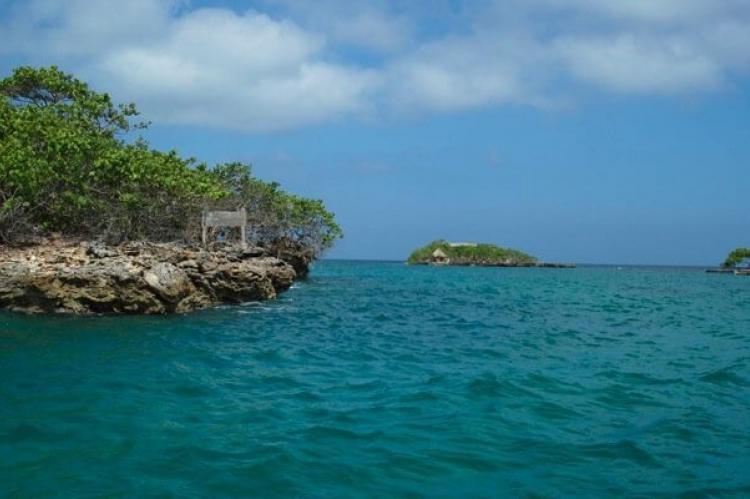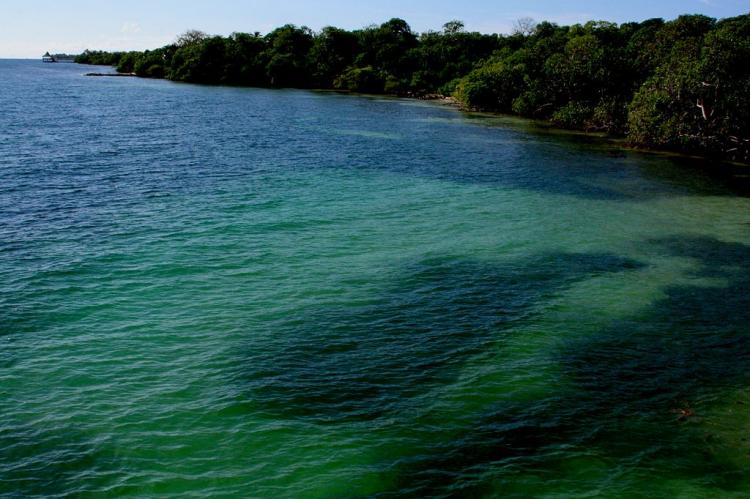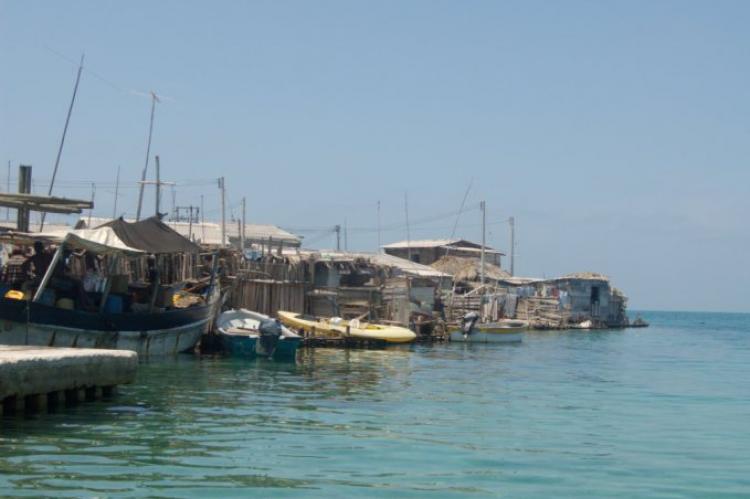Hidden Treasures of the Caribbean: The Rosario and San Bernardo Islands
The Rosario and San Bernardo Islands, situated off Colombia's Caribbean coast, are a collection of islands renowned for their beauty and biodiversity. Together with the surrounding coral reefs and underwater ecosystems, they form the Rosario and San Bernardo Corals National Natural Park.
Paradise Preserved: The Natural and Cultural Riches of the Rosario and San Bernardo Islands
The Rosario and San Bernardo Islands, situated off Colombia's Caribbean coast, are a stunning collection of small islands renowned for their natural beauty and biodiversity. These islands and the surrounding coral reefs and underwater ecosystems form the Rosario and San Bernardo Corals National Natural Park. This park is a critical marine conservation area, preserving one of the most important coral reef systems in the Colombian Caribbean. The islands and their ecosystems support a wide variety of marine life and serve as popular tourist destinations due to their pristine beaches and vibrant underwater landscapes.
Rosario Islands
The Rosario Islands, or Islas del Rosario, are an archipelago of around 28 small islands located approximately 100 km (62 mi) southwest of Cartagena, Colombia, in the Caribbean Sea. Administered by the Bolívar Department, these islands are part of Colombia's Caribbean Region and are included in the country's network of 46 Natural National Parks. The Rosario Islands are known for their crystal-clear waters, white sandy beaches, and lush mangrove ecosystems, making them popular for day trips and tourism.
The islands of the Rosario archipelago include:
- Big Island (Isla Grande)
- Marina Island (Isla Marina)
- Roberto Island (Isla Roberto)
- Treasure Island (Isla del Tesoro)
- Caribarú Island (Isla Caribarú)
- Arena Island (Isla Arena)
- Rosario Island (Isla Rosario)
- Pirate Island (Isla Pirata)
- Fiesta Island (Isla Fiesta)
- Cagua Island (Isla Cagua)
- Macaví Island (Isla Macaví)
- San Quintin Island (Isla San Quintin)
- Pavitos Island (Isla Pavitos)
- El Peñón Island (Isla El Peñón)
- Majayura Island (Isla Majayura)
- Maria del Mar Island (Isla Maria del Mar)
- Pajarales Island (Isla Pajarales)
- San Martin Island (Isla San Martin)
- Gigi Island (Isla Gigi)
- Coral Island (Isla Coral)
- Isla Pescadito
- Tijereto Island (Isla Tijereto)
- Pink Island (Isla Rosada)
Features and Attractions
The Rosario Islands are a significant natural habitat with diverse ecosystems, including coral reefs, mangrove forests, and seagrass beds. These islands are popular among tourists for snorkeling, scuba diving, and other water sports, allowing visitors to explore the rich marine biodiversity, including various fish species, coral formations, and marine invertebrates. The clear blue waters and coral reefs offer excellent visibility for underwater exploration, while the islands boast scenic beaches perfect for relaxation.
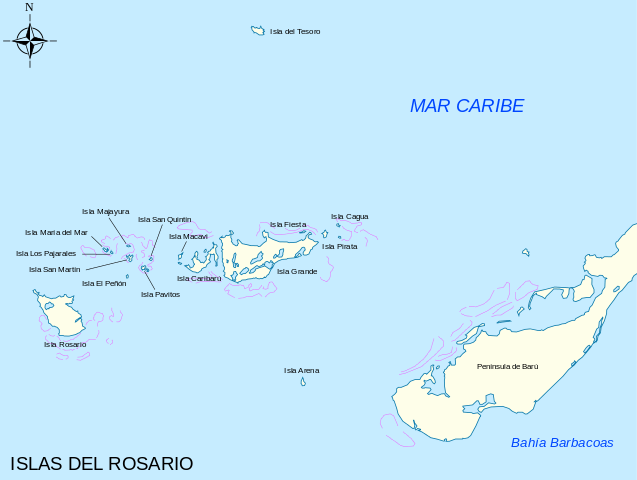
Map depicting the Rosario Islands.
San Bernardo Archipelago
The San Bernardo Archipelago (Archipiélago de San Bernardo) is a group of 10 coastal islands in the Gulf of Morrosquillo, also part of the Caribbean Sea. These islands, covering an approximate area of 213 sq km (82 sq mi), fall under the jurisdiction of the Bolívar Department. The San Bernardo Archipelago is known for its ecological significance and is less developed compared to the Rosario Islands, offering a more secluded and serene experience.
The San Bernardo Archipelago includes the following islands:
- Boquerón Island (Isla Boquerón)
- Palma Island (Isla Palma)
- Panda Island (Isla Panda)
- Mangle Island (Isla Mangle)
- Ceycén Island (Isla Ceycén)
- Cabruna Island (Isla Cabruna)
- Tintipán Island (Isla Tintipán)
- Maravilla Island (Isla Maravilla)
- Múcura Island (Isla Múcura)
- Santa Cruz del Islote (Holy Cross Islet)
Notable Islands
- Santa Cruz del Islote: This artificial islet is known for its high population density, estimated at around 1,200 people living on a mere 0.012 sq km (0.0046 sq mi). The islet was constructed by locals using coral and other materials, beginning around 1870. Due to its limited space, some inhabitants have moved to nearby islands such as Tintipán and Múcura.
- Tintipán and Múcura Islands: These islands are known for their natural beauty, with sandy beaches and clear waters ideal for swimming, snorkeling, and relaxation. Tintipán, in particular, is celebrated for its bioluminescent plankton, which lights up the waters at night, offering a magical experience to visitors.
Rosario and San Bernardo Corals National Natural Park
The Rosario and San Bernardo Corals National Natural Park was established in 1988 to protect one of the most vital coral reef systems along Colombia's Caribbean coast. The park covers an area of 120,000 sq km (46,300 sq mi) and covers both the Rosario and San Bernardo archipelagos and the surrounding marine environment.
Ecological Importance
The park safeguards diverse marine habitats, including coral reefs, mangrove swamps, and seagrass meadows. These ecosystems are home to hundreds of marine species, such as fish, mollusks, crustaceans, and various types of coral. The park's coral reefs are particularly notable for their extent and biodiversity, representing some of the most developed coral formations along the continental shelf of the Colombian Caribbean.
Conservation Efforts
Within the park, four islands are designated as untouchable zones to preserve their natural state: two in the Rosario Archipelago (Tesoro and Rosario Islands) and two in the San Bernardo Archipelago (Maravilla and Mangle Islands). These protected areas help maintain the ecological balance and support conservation research and educational initiatives.
Climate and Environment
The Rosario and San Bernardo Islands experience a tropical maritime climate characterized by warm temperatures throughout the year, with an average annual temperature of about 27°C (81°F). The region sees distinct wet and dry seasons, with the rainy season occurring from May to November, bringing increased humidity and occasional tropical storms.
Tourism and Accessibility
These islands are accessible by boat from Cartagena, making them popular for day trips and extended stays. Tourists flock to the islands to enjoy the natural beauty, engage in water sports, and explore the vibrant marine life. Several islands have accommodations ranging from luxury resorts to more rustic lodges, catering to various preferences and budgets. Coral reefs, shipwrecks, and underwater caves make the Rosario and San Bernardo Islands a premier destination for diving enthusiasts.
Cultural and Historical Significance
Apart from their natural beauty, the islands hold cultural importance due to their historical connection to Indigenous communities and their role in Colombia's maritime history. Efforts to preserve the natural environment are complemented by initiatives to maintain the cultural heritage of the local communities, ensuring that both natural and cultural landscapes are respected and protected.
Conclusion
The Rosario and San Bernardo Islands, along with the Rosario and San Bernardo Corals National Natural Park, represent a crucial area for marine biodiversity conservation and a popular destination for ecotourism in Colombia. The combination of pristine beaches, diverse ecosystems, and rich cultural history makes this region a unique and valuable part of Colombia's natural heritage. Continued efforts in conservation and sustainable tourism practices are essential to preserve these natural wonders for future generations.
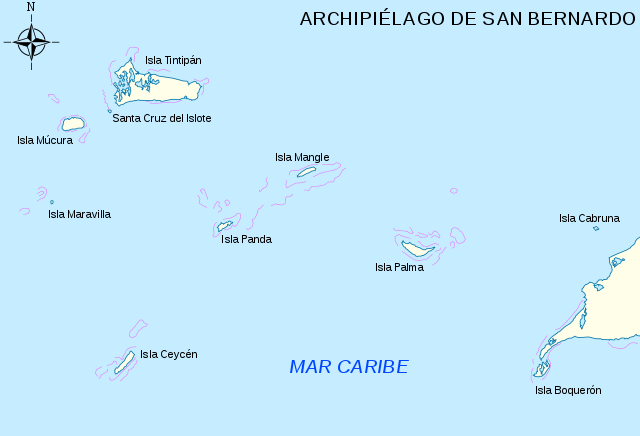
Map depicting the San Bernardo Archipelago.
